Family: Siricidae
Subfamily: Siricinae
Genus: Sirex Linnaeus, 1760
Species: Sirex noctilio Fabricius, 1793
Common names: sirex woodwasp, European woodwasp, Eurasian woodwasp
Sirex noctilio is a PalearcticPalearctic:
describing the region of the northern hemisphere that includes Europe, Asia south to the Himalayas and northern Africa
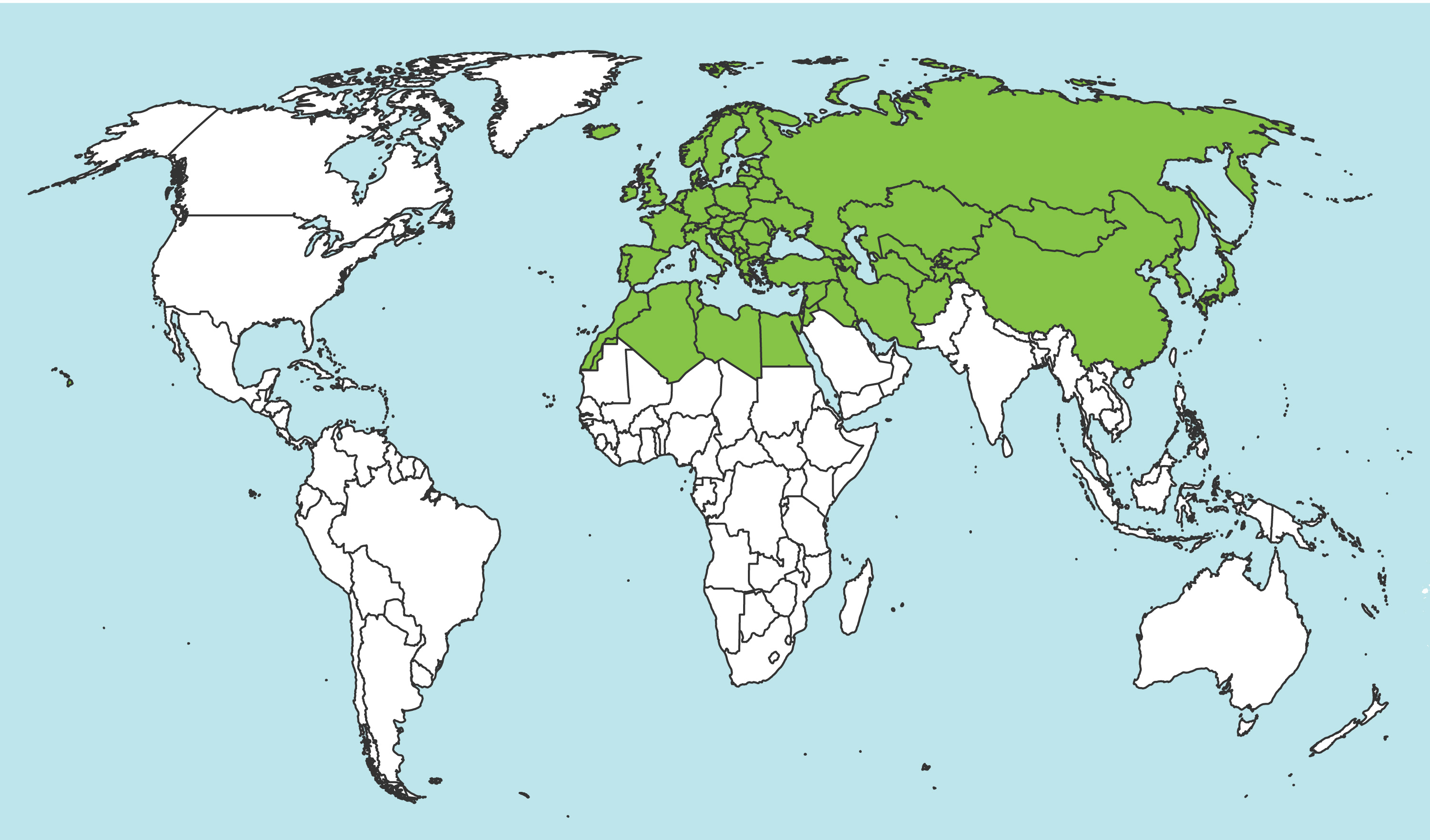 species that has been introduced and become established in several regions around the world. This species is well-known as a forestry pest but is often difficult to distinguish from other Sirex species (Schiff et al. 2012Schiff et al. 2012:
species that has been introduced and become established in several regions around the world. This species is well-known as a forestry pest but is often difficult to distinguish from other Sirex species (Schiff et al. 2012Schiff et al. 2012:
Schiff NM, Goulet H, Smith DR, Boudreault C, Wilson AD, and Scheffler BE. 2012. Siricidae (Hymenoptera: Symphyta: Siricoidea) of the Western Hemisphere. Canadian Journal of Arthropod Identification 21: 1-305.).
See Sirex for genus-level diagnostic characteristics.
Females:
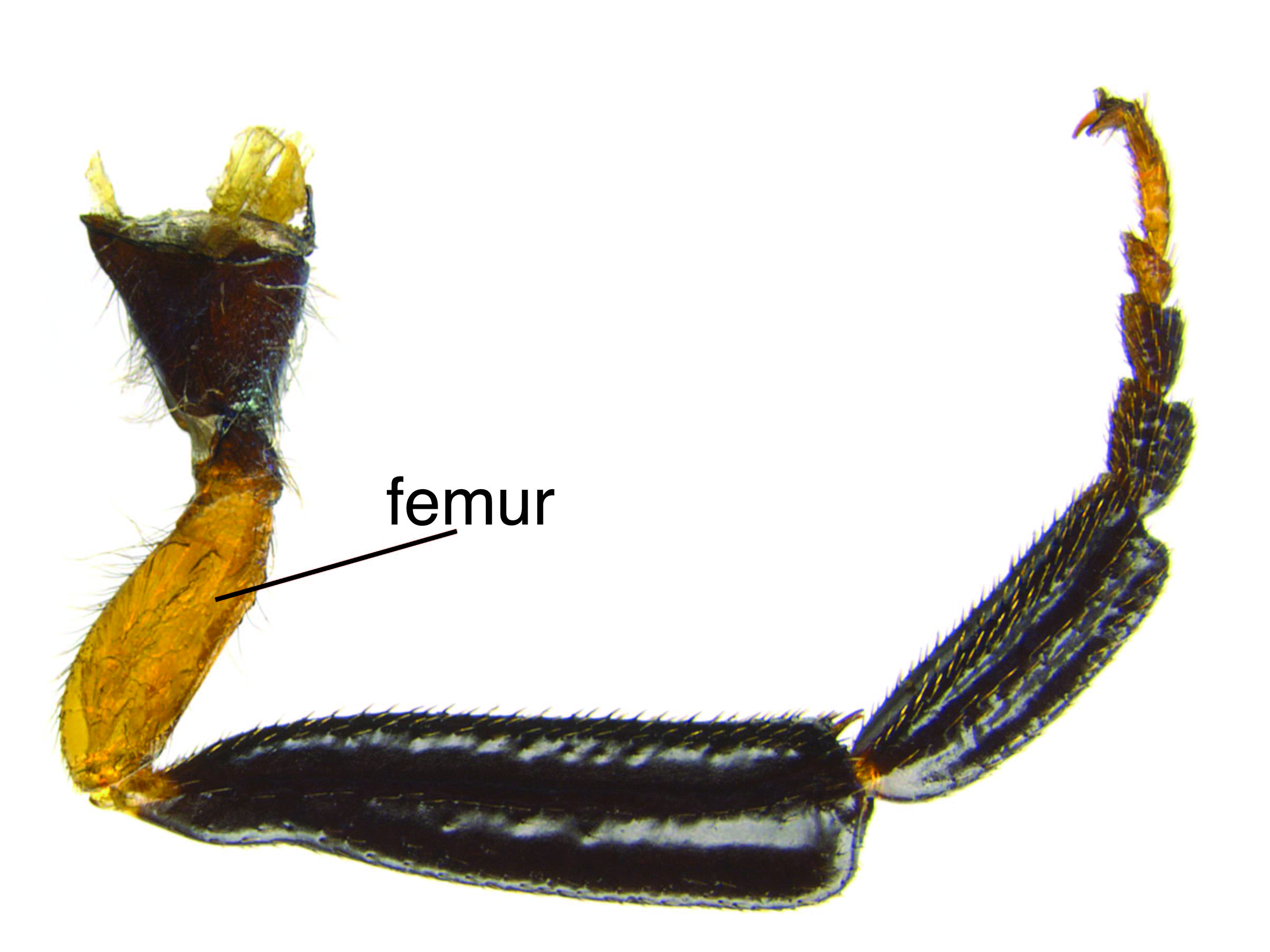 usually light reddish-brown and rarely partially black or entirely black (only specimens from southern Europe) (Schiff et al. 2012Schiff et al. 2012:
usually light reddish-brown and rarely partially black or entirely black (only specimens from southern Europe) (Schiff et al. 2012Schiff et al. 2012: hyaline and rarely darkened (only specimens from southern Europe) (Schiff et al. 2012Schiff et al. 2012:
hyaline and rarely darkened (only specimens from southern Europe) (Schiff et al. 2012Schiff et al. 2012: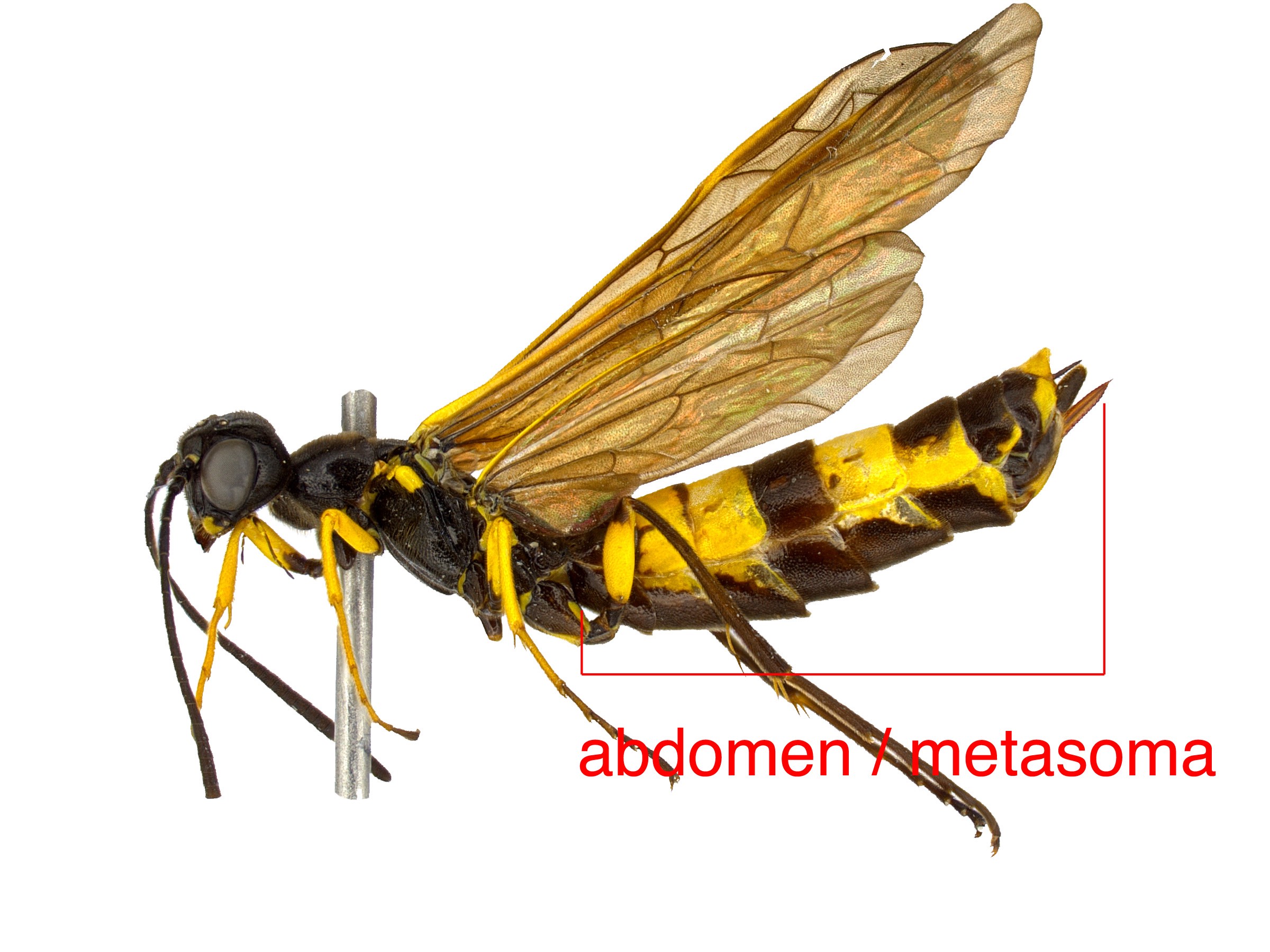 metallic blue-black (Schiff et al. 2012Schiff et al. 2012:
metallic blue-black (Schiff et al. 2012Schiff et al. 2012: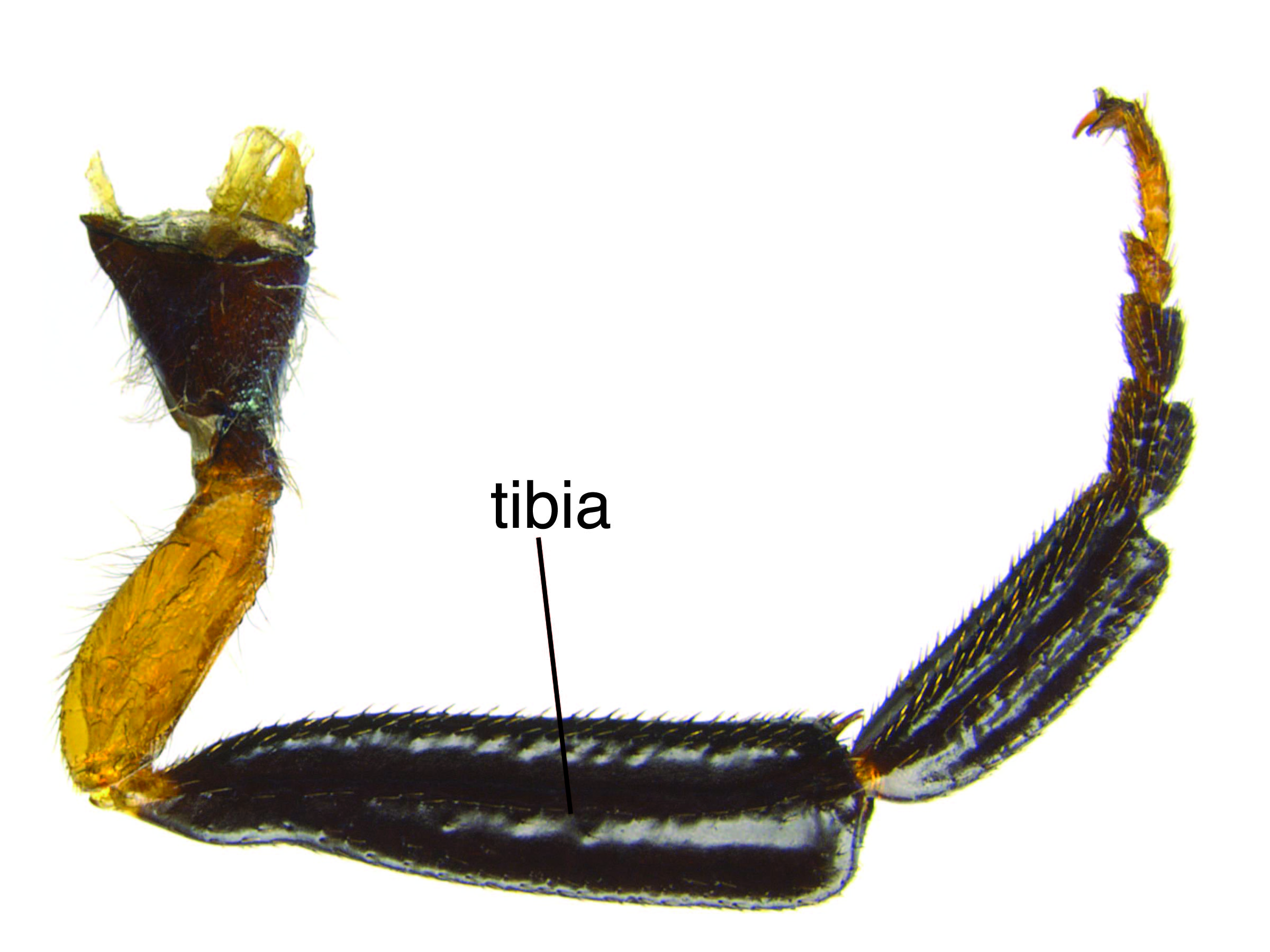 light reddish-brown (Schiff et al. 2012Schiff et al. 2012:
light reddish-brown (Schiff et al. 2012Schiff et al. 2012: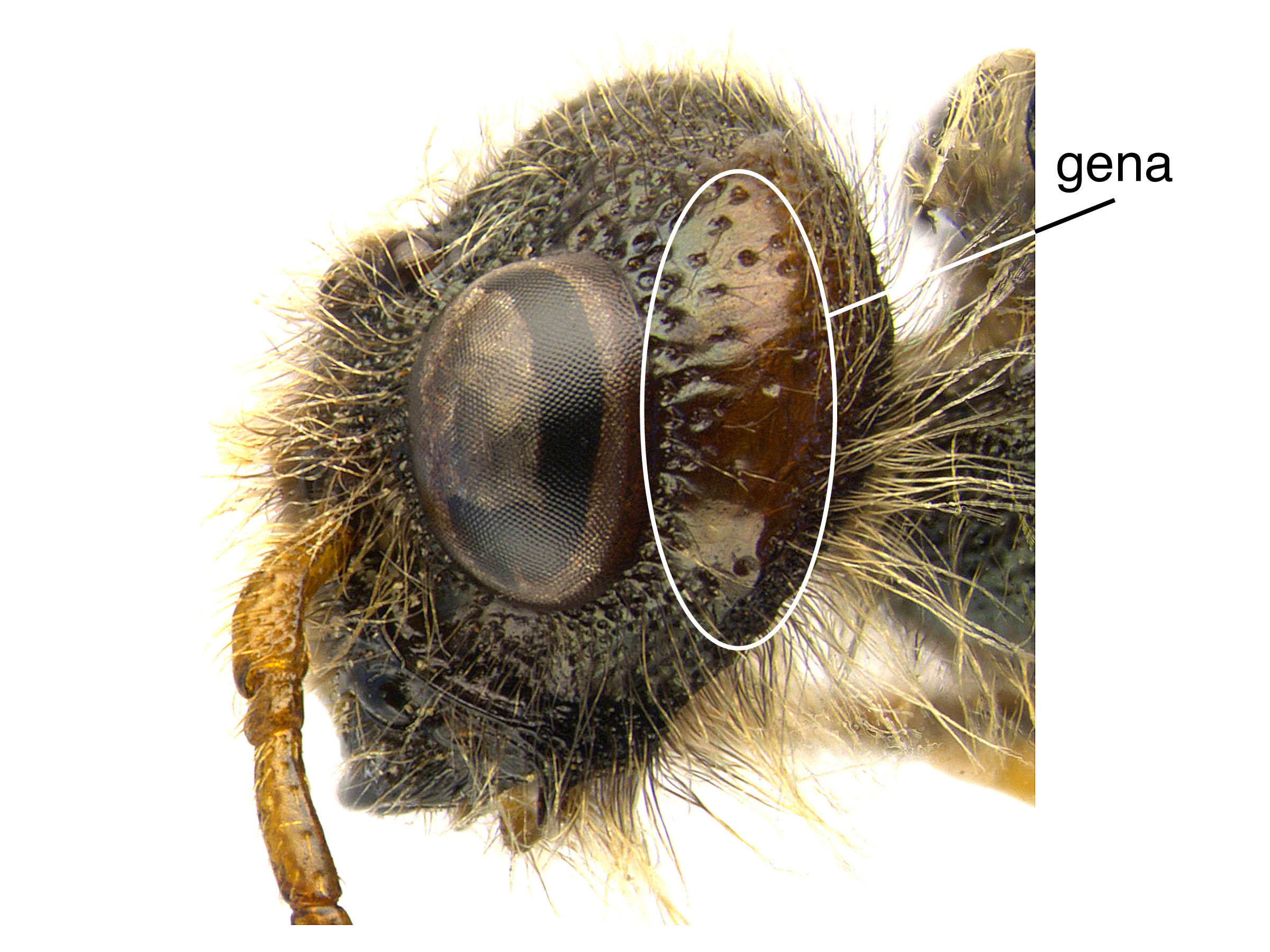 small, about 0.1–0.25 times size of laterallateral:
small, about 0.1–0.25 times size of laterallateral: scattered, about 2–10 pit diameters apart (Schiff et al. 2012Schiff et al. 2012:
scattered, about 2–10 pit diameters apart (Schiff et al. 2012Schiff et al. 2012: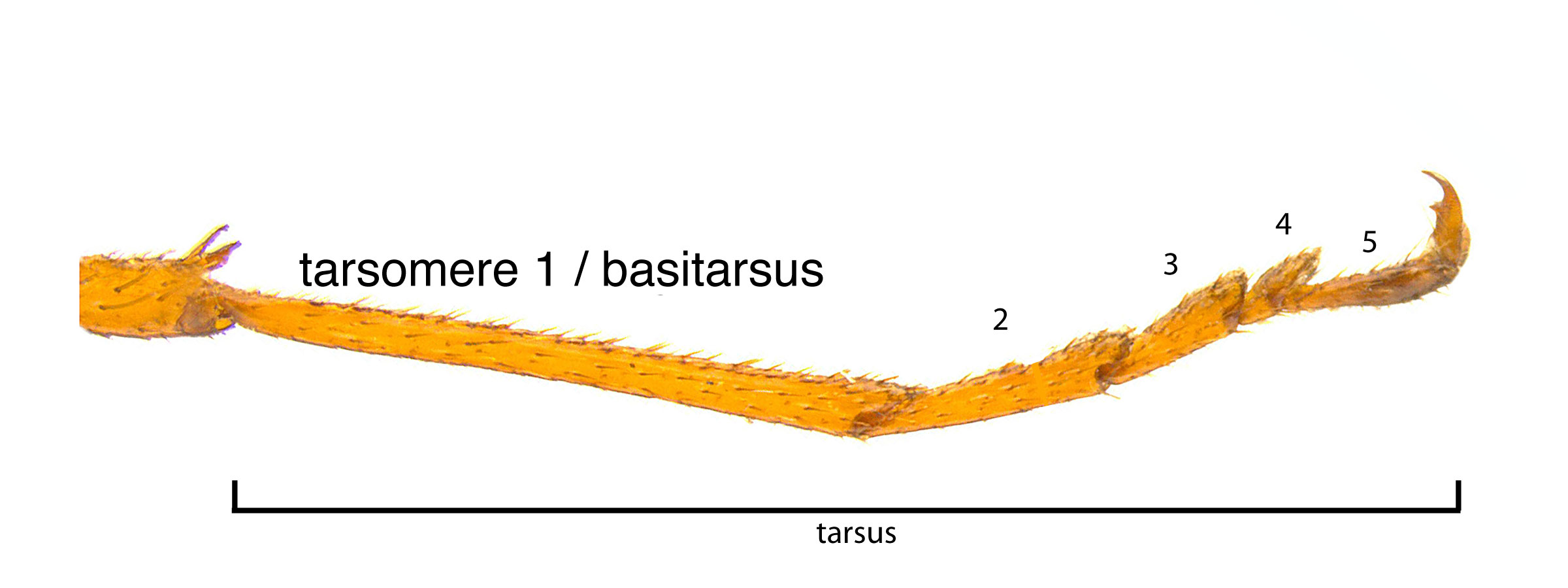 2–3.5 times as long as wide (Schiff et al. 2012Schiff et al. 2012:
2–3.5 times as long as wide (Schiff et al. 2012Schiff et al. 2012: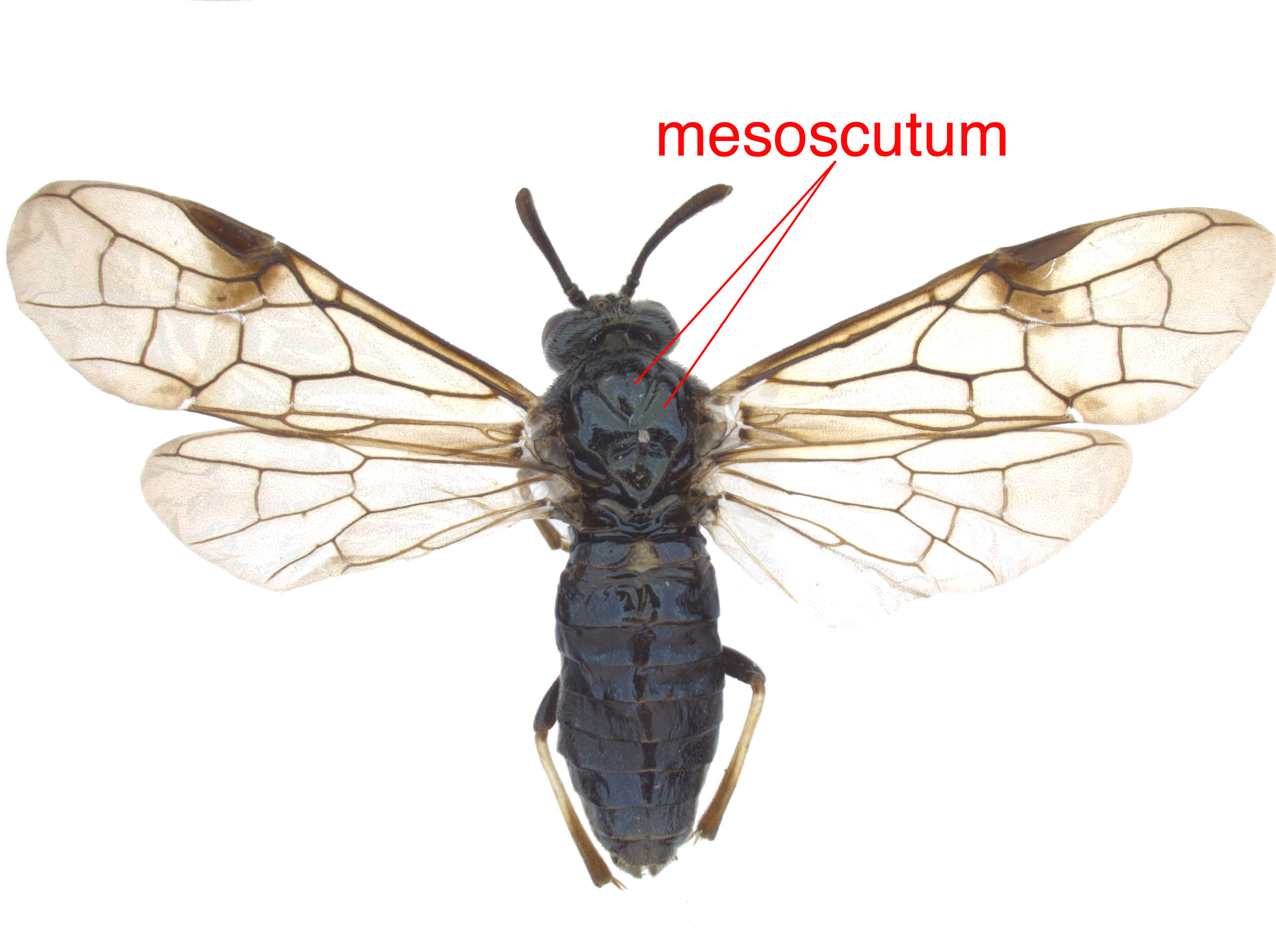 pits with a posterior tooth, pits sometimes arranged in transverse ridges (Schiff et al. 2012Schiff et al. 2012:
pits with a posterior tooth, pits sometimes arranged in transverse ridges (Schiff et al. 2012Schiff et al. 2012: 5 dark brown or black (Schiff et al. 2012Schiff et al. 2012:
5 dark brown or black (Schiff et al. 2012Schiff et al. 2012: with pulvilluspulvillus:
with pulvilluspulvillus: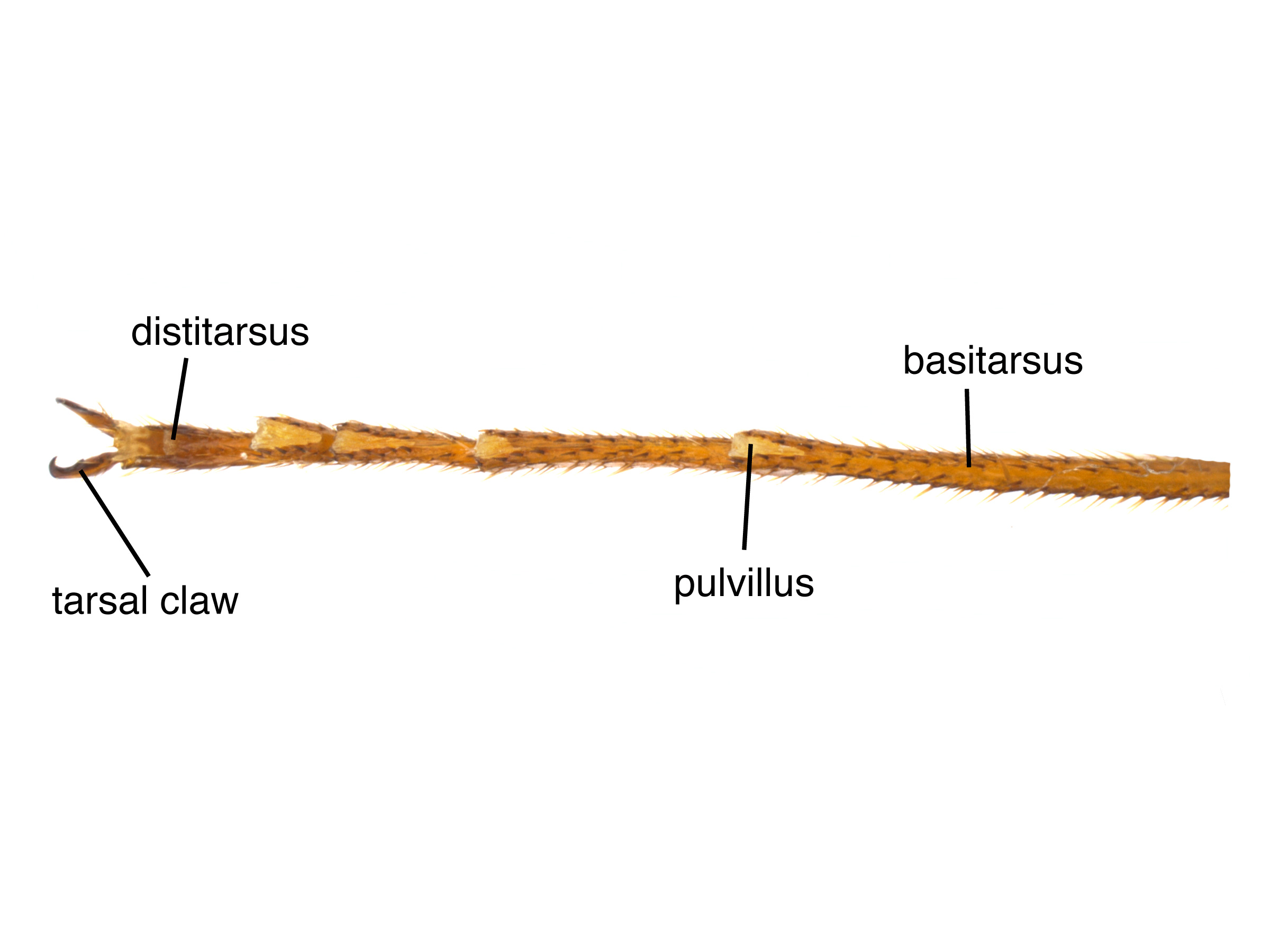 0.3–0.4 times length of tarsomeretarsomere:
0.3–0.4 times length of tarsomeretarsomere: (Schiff et al. 2012Schiff et al. 2012:
(Schiff et al. 2012Schiff et al. 2012: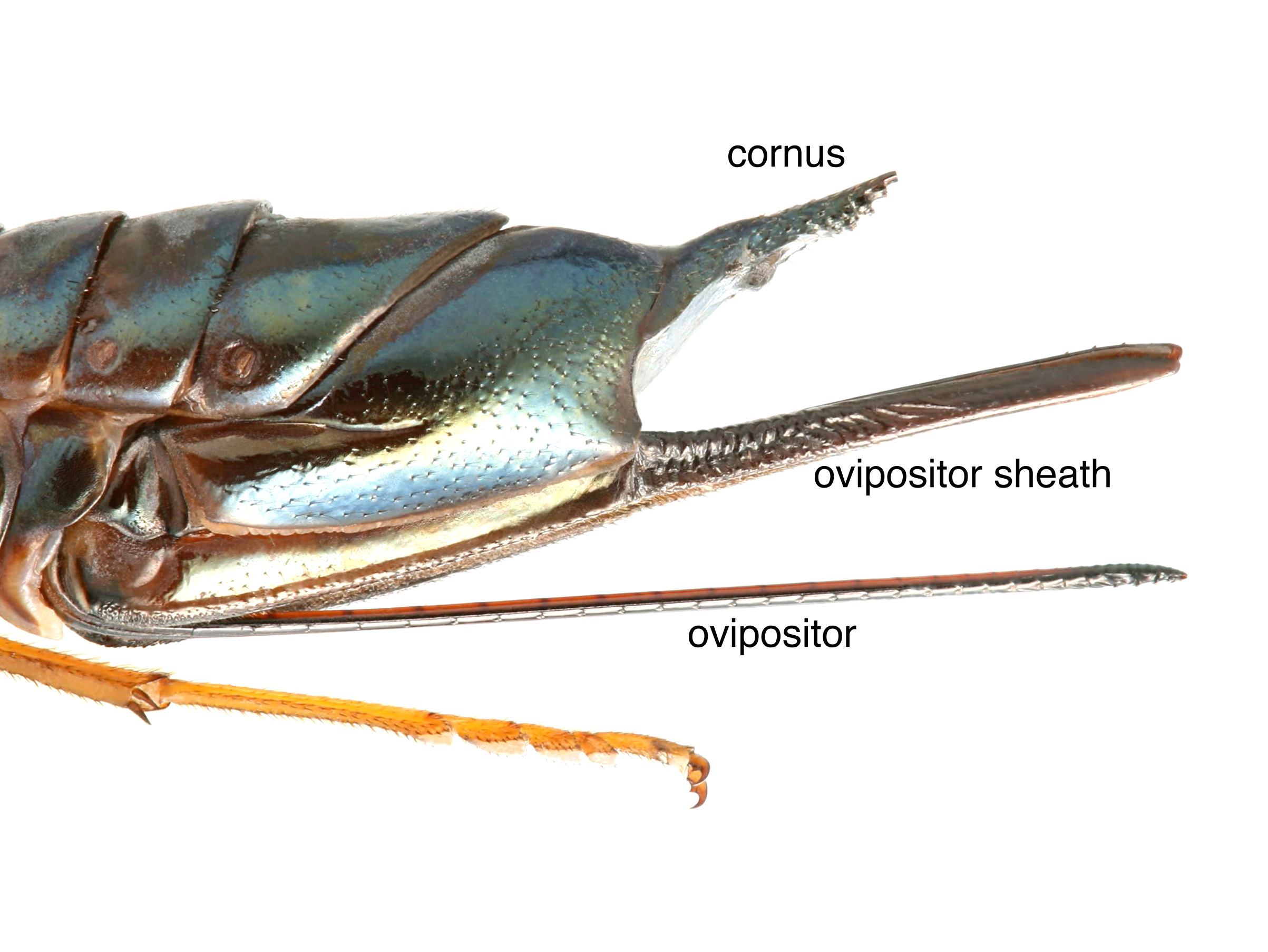 pits 0.5–0.75 times length of annulusannulus:
pits 0.5–0.75 times length of annulusannulus: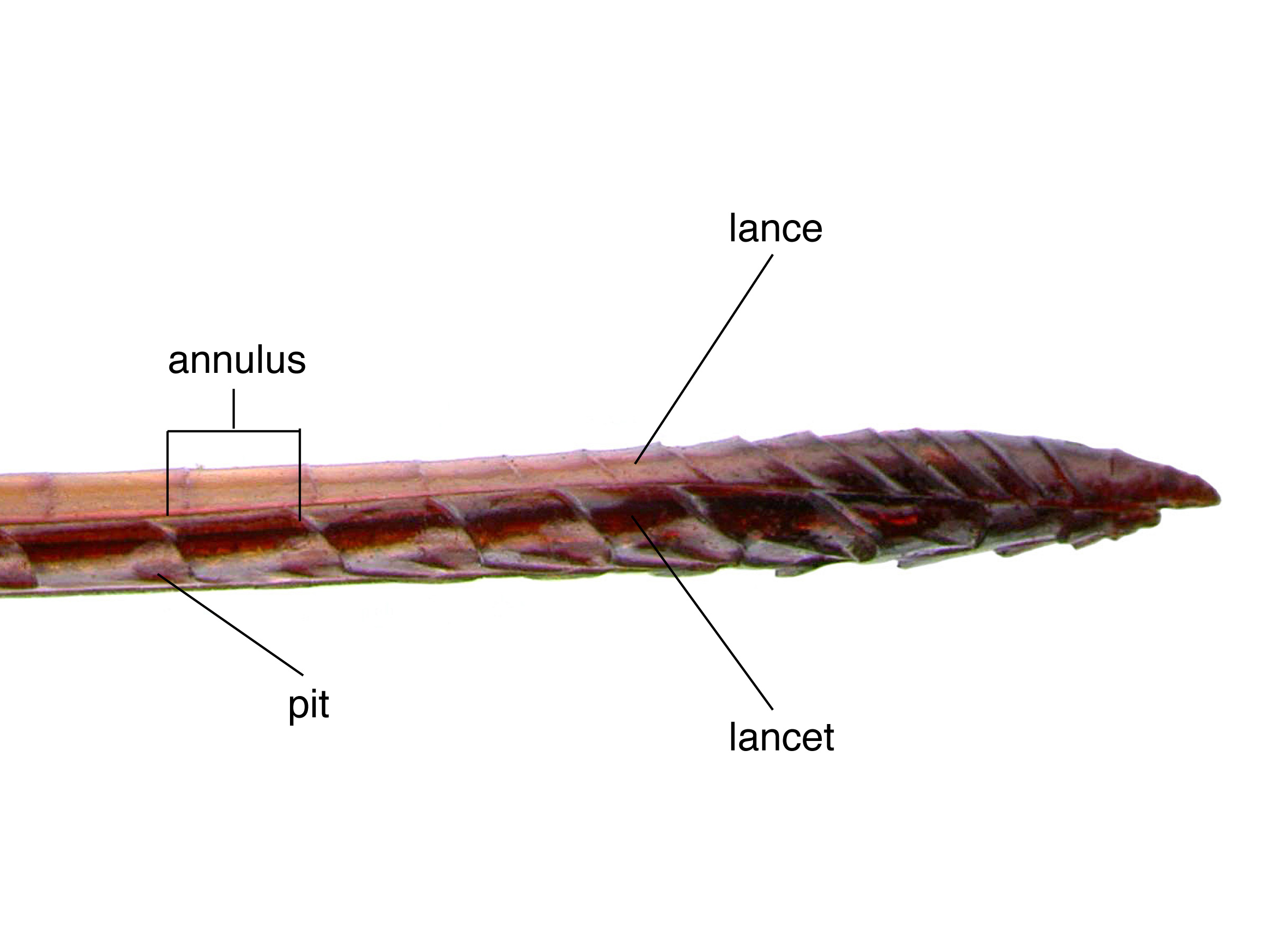 (Schiff et al. 2012Schiff et al. 2012:
(Schiff et al. 2012Schiff et al. 2012: to fore wingfore wing:
to fore wingfore wing: ratio about 1:1.5 (Benson 1943Benson 1943:
ratio about 1:1.5 (Benson 1943Benson 1943:Males:
 completely reddish-brown (Schiff et al. 2012Schiff et al. 2012:
completely reddish-brown (Schiff et al. 2012Schiff et al. 2012: dark blue with metallic reflections (Schiff et al. 2012Schiff et al. 2012:
dark blue with metallic reflections (Schiff et al. 2012Schiff et al. 2012: usually with wide band of reddish-brown at basebase:
usually with wide band of reddish-brown at basebase: pits with a posterior tooth, margins not joined, pits rounded (Schiff et al. 2012Schiff et al. 2012:
pits with a posterior tooth, margins not joined, pits rounded (Schiff et al. 2012Schiff et al. 2012: pits generally 1–3 diameters apart posterodorsallyposterodorsal:
pits generally 1–3 diameters apart posterodorsallyposterodorsal:Several NearcticNearctic:
describing the region of the Northern Hemisphere that includes North America south through northern Mexico
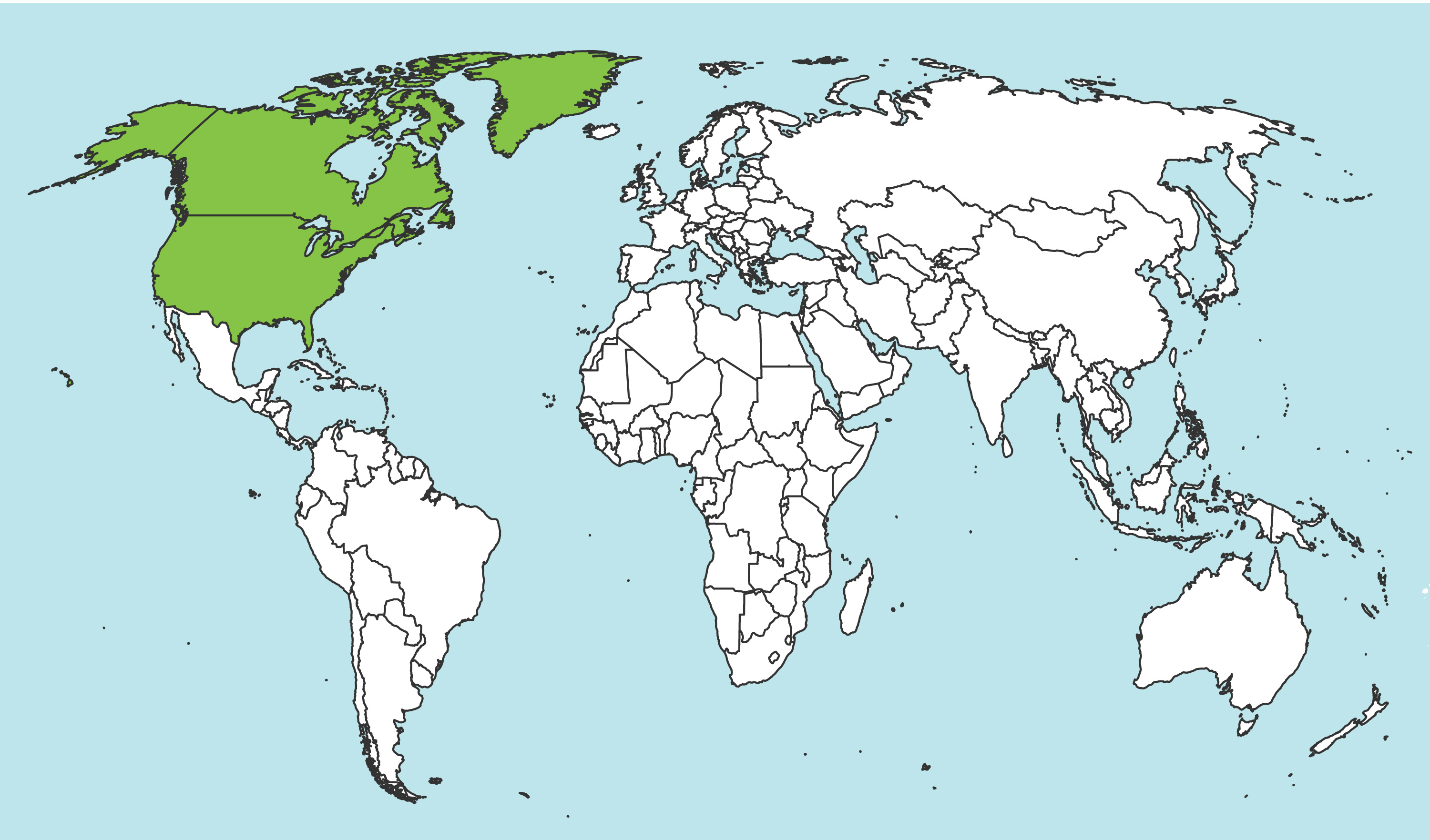 species have similar coloration to S. noctilio, with reddish legs and a black abdomenabdomen:
species have similar coloration to S. noctilio, with reddish legs and a black abdomenabdomen:
the third and last segment of an insect's body; in sawflies this is usually made up of 11 segments (segments 9 and 10 often fused) . The female can be distinguished in North America by the relatively short pulvillipulvillus:
. The female can be distinguished in North America by the relatively short pulvillipulvillus:
soft pads used for surface adhesion, located in sawflies on the first 4 segments of the tarsus
 and the larger size of the pits on the ovipositorovipositor:
and the larger size of the pits on the ovipositorovipositor:
the female organ that deposits eggs and is used to drill into plant tissue, located at the apex of the abdomen, made up of the lance and lancet
 . The male can be distinguished by the wide reddish-brown band at the basebase:
. The male can be distinguished by the wide reddish-brown band at the basebase:
the beginning or most proximal area of any structure
of the hind tibiatibia:
the fourth segment of the leg, between the femur and the tarsus
 (Schiff et al. 2012Schiff et al. 2012:
(Schiff et al. 2012Schiff et al. 2012:
Schiff NM, Goulet H, Smith DR, Boudreault C, Wilson AD, and Scheffler BE. 2012. Siricidae (Hymenoptera: Symphyta: Siricoidea) of the Western Hemisphere. Canadian Journal of Arthropod Identification 21: 1-305.). Of European species, S. noctilio has similar coloration to S. juvencus and S. torvus. Sirex noctilio can be distinguished in this range by the black apicalapical:
towards the apex; farthest away from the body
hind tarsomeretarsomere:
a segment of the tarsus
 and the shorter ovipositorovipositor:
and the shorter ovipositorovipositor:
the female organ that deposits eggs and is used to drill into plant tissue, located at the apex of the abdomen, made up of the lance and lancet
 (Benson 1943Benson 1943:
(Benson 1943Benson 1943:
Benson RB. 1943. Studies in Siricidae, especially of Europe and southern Asia (Hymenoptera, Smphyta). Bulletin of Entomological Research 34 (1): 27-51. https://doi.org/10.1017/S0007485300023464).
There are two color morphs of S. noctilio. The light form found throughout its range has light-colored femorafemur:
the third segment of the leg between the trochanter and the tibia
 and clear wings, while the dark form, found only in Spain, Portugal, Turkey, Italy, and the Azores islands, has black femorafemur:
and clear wings, while the dark form, found only in Spain, Portugal, Turkey, Italy, and the Azores islands, has black femorafemur:
the third segment of the leg between the trochanter and the tibia
 and darkened wings (Schiff et al. 2012Schiff et al. 2012:
and darkened wings (Schiff et al. 2012Schiff et al. 2012:
Schiff NM, Goulet H, Smith DR, Boudreault C, Wilson AD, and Scheffler BE. 2012. Siricidae (Hymenoptera: Symphyta: Siricoidea) of the Western Hemisphere. Canadian Journal of Arthropod Identification 21: 1-305.).
Sirex species feed on trees of Pinaceae and Cupressaceae. Throughout the world, Sirex noctilio is mostly recorded on species of pine: Pinus contorta (lodgepole pine), Pinus resinosa (red pine), Pinus sylvestris (Scots pine), Pinus strobus (eastern white pine), Pinus caribea (Caribbean pine), Pinus echinata (shortleaf pine), Pinus elliottii (slash pine), Pinus kesiya (Khasia pine), Pinus nigra (Austrian pine), Pinus palustris (longleaf pine), Pinus patula (Mexican weeping pine), Pinus pinaster (maritime pine), Pinus pinea (stone pine), Pinus radiata (Monterey pine), and Pinus taeda (loblolly pine). Some European specimens have been reared from a single non-pine species, Pseudotsuga menziesii (Douglas fir) (Schiff et al. 2012Schiff et al. 2012:
Schiff NM, Goulet H, Smith DR, Boudreault C, Wilson AD, and Scheffler BE. 2012. Siricidae (Hymenoptera: Symphyta: Siricoidea) of the Western Hemisphere. Canadian Journal of Arthropod Identification 21: 1-305.).
Female Sirex harbor symbiotic basidiomycete fungus in abdominal glands called mycangia. During oviposition, the site is inoculated with the fungus, which begins to decompose the surrounding wood. LarvaeLarva:
the immature stage of holometabolous insects
 feed on the fungus, and in the process bore galleries through the wood (Johnson 1930Johnson 1930:
feed on the fungus, and in the process bore galleries through the wood (Johnson 1930Johnson 1930:
Johnson CW. 1930. On the variation and abundance of Sirex nitidus Harris. Psyche 37 (3): 281-282. https://doi.org/10.1155/1930/62786, Schiff et al. 2012Schiff et al. 2012:
Schiff NM, Goulet H, Smith DR, Boudreault C, Wilson AD, and Scheffler BE. 2012. Siricidae (Hymenoptera: Symphyta: Siricoidea) of the Western Hemisphere. Canadian Journal of Arthropod Identification 21: 1-305.). The mycangia of S. noctilio harbor Amylostereum areolatum fungus (Hajek et al. 2013Hajek et al. 2013:
Hajek AE, Nielsen C, Kepler RM, Long SJ, and Castrillo L. 2013. Fidelity among Sirex woodwasps and their fungal symbionts. Microbial Ecology 65: 753-762. https://doi.org/10.1007/s00248-013-0218-z). This species also deposits a plant toxin in the form of a mucus, that weakens plant cells to encourage the fungus’ growth (Hajek and Morris 2014Hajek and Morris 2014:
Hajek AE and Morris EE. 2014. XXXII Sirex woodwasp ( Sirex noctilio Fabricius) (Hymenoptera: Siricidae). In: Van Driesche R and Reardon R, eds. The use of classical biological control to preserve forests in North America. USDA Forest Service Forest Health Technology Enterprise Team FHTET-2013-2.).
Larvae are creamy white and grub-like in appearance with a dark head capsule. As with adults, larvaelarva:
the immature stage of holometabolous insects
 possess a short dorsaldorsal:
possess a short dorsaldorsal:
of or on the top surface of the body or structure
horn on the posterior end of the body. The larvaelarva:
the immature stage of holometabolous insects
 bore galleries into wood, feeding until pupation and subsequent emergence. Throughout this process, the larvaelarva:
bore galleries into wood, feeding until pupation and subsequent emergence. Throughout this process, the larvaelarva:
the immature stage of holometabolous insects
 use their horn to pack the tunnel behind them with sawdust. Emergence holes are perfectly circular. The fungal symbiont is carried in specialized organs in female larvaelarva:
use their horn to pack the tunnel behind them with sawdust. Emergence holes are perfectly circular. The fungal symbiont is carried in specialized organs in female larvaelarva:
the immature stage of holometabolous insects
 that develop into the mycangia after metamorphosis (Schiff et al. 2012Schiff et al. 2012:
that develop into the mycangia after metamorphosis (Schiff et al. 2012Schiff et al. 2012:
Schiff NM, Goulet H, Smith DR, Boudreault C, Wilson AD, and Scheffler BE. 2012. Siricidae (Hymenoptera: Symphyta: Siricoidea) of the Western Hemisphere. Canadian Journal of Arthropod Identification 21: 1-305.).
The documented flight period of S. noctilio is early July through early October, with most collections in late July and early August (Schiff et al. 2012Schiff et al. 2012:
Schiff NM, Goulet H, Smith DR, Boudreault C, Wilson AD, and Scheffler BE. 2012. Siricidae (Hymenoptera: Symphyta: Siricoidea) of the Western Hemisphere. Canadian Journal of Arthropod Identification 21: 1-305.).
In regions where they are native, S. notilio horntails are a secondary pest that attacks dead or damaged trees. However, in other regions, S. noctilio is documented ovipositing into otherwise healthy trees. The phytotoxicphytotoxic:
toxic to plants; poisons and sometimes kills plant tissue
mucus in conjunction with the fungus exacerbates the damage to the tree. For these reasons, S. noctilio is considered an important forest pest (Hajek and Morris 2014Hajek and Morris 2014:
Hajek AE and Morris EE. 2014. XXXII Sirex woodwasp ( Sirex noctilio Fabricius) (Hymenoptera: Siricidae). In: Van Driesche R and Reardon R, eds. The use of classical biological control to preserve forests in North America. USDA Forest Service Forest Health Technology Enterprise Team FHTET-2013-2.).
Infestations of S. noctilio have resulted in ecological and economic loss. One incident in Australia in the 1980s sawsaw:
ovipositor
the death of 1.8 million trees in a pine plantation (Hajek and Morris 2014Hajek and Morris 2014:
Hajek AE and Morris EE. 2014. XXXII Sirex woodwasp ( Sirex noctilio Fabricius) (Hymenoptera: Siricidae). In: Van Driesche R and Reardon R, eds. The use of classical biological control to preserve forests in North America. USDA Forest Service Forest Health Technology Enterprise Team FHTET-2013-2.). Outbreaks are correlated with drought and overcrowded stands, which may create stress and decrease resiliency in the affected tree (Madden 1988Madden 1988:
Madden JL. 1988. Chapter 20 - Sirex in Australasia. Pp. 407-429. In: Berryman AA ed. Dynamics of Forest Insect Populations. Springer Science and Business Media New York.).
Several parasitoid wasp species and a species of parasitic nematodes, Deladenus siricidicola, that kill S. noctilio larvae are being considered and used for biological control of this pest (Hajek et al. 2013Hajek et al. 2013:
Hajek AE, Nielsen C, Kepler RM, Long SJ, and Castrillo L. 2013. Fidelity among Sirex woodwasps and their fungal symbionts. Microbial Ecology 65: 753-762. https://doi.org/10.1007/s00248-013-0218-z, Hajek and Morris 2014Hajek and Morris 2014:
Hajek AE and Morris EE. 2014. XXXII Sirex woodwasp ( Sirex noctilio Fabricius) (Hymenoptera: Siricidae). In: Van Driesche R and Reardon R, eds. The use of classical biological control to preserve forests in North America. USDA Forest Service Forest Health Technology Enterprise Team FHTET-2013-2.).
World: The original range of S. noctilio is Europe east to Siberia. It was introduced, likely through trade of wood products, and became established in Australia, New Zealand, South Africa, Argentina, Uruguay, Brazil, Chile, and North America (Schiff et al. 2012Schiff et al. 2012:
Schiff NM, Goulet H, Smith DR, Boudreault C, Wilson AD, and Scheffler BE. 2012. Siricidae (Hymenoptera: Symphyta: Siricoidea) of the Western Hemisphere. Canadian Journal of Arthropod Identification 21: 1-305.).
North America: The first introduction of S. noctilio was recorded in northern Ontario in the early 1880s. It has since established in the Great Lakes region and occurs in Ontario, New York, and Pensylvannia (Schiff et al. 2012Schiff et al. 2012:
Schiff NM, Goulet H, Smith DR, Boudreault C, Wilson AD, and Scheffler BE. 2012. Siricidae (Hymenoptera: Symphyta: Siricoidea) of the Western Hemisphere. Canadian Journal of Arthropod Identification 21: 1-305.).
Map data from: GBIF.org (26 June 2019) GBIF Occurrence Download Sirex noctilio
Details about data used for maps can be found here.